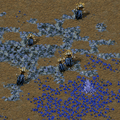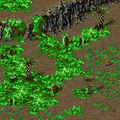Sheldonist (talk | contribs) (→Unknown red strain{{NoRef}}: had a fake/modded image of Tratos with a blue Tib crystal that was painted orange, challenging the reality of the entire section) |
Sheldonist (talk | contribs) No edit summary |
||
| Line 1: | Line 1: | ||
| − | {{Games|TD|CO|TS|FS|Ren|TW|KW|Tib|TT|RIV}} |
+ | {{Games|TD|CO|TS|FS|Ren|TI|TW|KW|Tib|CC4MC|TT|RIV}} |
{{for|This=the substance|cancelled first person shooter of the same name|Tiberium (game)}} |
{{for|This=the substance|cancelled first person shooter of the same name|Tiberium (game)}} |
||
{{ResourceBox |
{{ResourceBox |
||
Revision as of 07:56, 11 August 2018
| For cancelled first person shooter of the same name, see Tiberium (game). |
| “ | Molecularly, Tiberium is a noncarbon-based element that appears to have strong ferrous qualities with non-resonating reversible energy, which has a tendency to disrupt carbon-based molecular structures, with inconsequent and unequal positrons orbiting on the first, second and ninth quadrings! (...) The possibilities of Tiberium... are limitless! - Ignatio Mobius |
” |
Tiberium (called Ichor by the Scrin) is a mysterious crystalline material that arrived on Earth in 1995 and is the foundation of the Tiberium Universe.
It is the main resource in the Tiberium Universe, having enough value when processed to directly fund armies.
Naming
| “ | About Tiberium, about the place it has in our world. GDI always says it's an invader, but it's not true. Kane thought it was an instrument to use... to control because what they don't understand is that Kane was just the messenger. The real Messiah is Tiberium! - Gideon to Christian Pierce |
” |
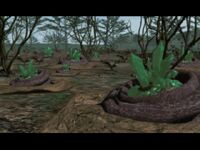
The first Tiberium deposit near the Tiber river, Italy
Many have laid claim to naming this clearly extraterrestrial element, including Kane, who claims to have named it after the great Roman emperor, Julius Caesar Augustus Tiberius, though it is officially named after the place of its discovery near the Tiber river in Italy. The ium was added to give a material relevance. Since then, Tiberium has come to be known universally by all inhabitants of Earth.
Ichor, the Scrin name for Tiberium, is believed to have been garnered from the blood of the gods of ancient Greek mythology. If this is so, then it sheds light on the particularly disturbing possibility that the aggressive alien race had been waiting either within or just outside the Solar system for millennia.
Characteristics
Tiberium leeches metals and other heavy minerals out of the soil, concentrating them in crystals which can be easily collected by specialized vehicles (Harvesters) and processed (in a specially designed Tiberium refinery) into easy to use resources. As such, it is an amazing opportunity for any economy. Harvesters (large, heavily armoured vehicles with specialised equipment) collect the crystal by sweeping it up from the ground. The crystal's growth speed and mineral content depends on variables such as soil conditions, moisture, yearly-average temperature, and local weather.
It also had a deadly effect on the environment and all carbon-based life. Between 1995 and c.a. 2034 it covered much of the planet, transforming and adapting flora and fauna to its alien nature. Spores and gases emitted by Tiberium-mutated plant life had led to the danger of Earth becoming uninhabitable for humans, as the concentration of Tiberium pollutants in the air reached critical levels. GDI initiated reclamation efforts which seem to have led to Tiberium's evolution, changing its features and proliferation in some ways. However, the crystal did not lose its hostile qualities, becoming the perfect assimilator.
Many theories exist on what Tiberium really is. Some, such as Dr. Ignatio Mobius, believed that Tiberium itself is a lifeform rather than a mineral. This hypothesis seems to be based on early forms of Tiberium, which originally occurred as seemingly organic, plant-like pods. This theory is supported by the symbiotic relationship Tiberium shares with mutated lifeforms, its ability to corrupt lifeforms such as trees and convert them to spread more of the substance, and Tiberium's apparent ability to adapt over time, becoming resistant to reclamation efforts.
One fanciful hypothesis is that Tiberium possesses consciousness. According to this idea, the crystal contains a quantum crystalline brain that grows more intelligent as it grows and grows. However, this has yet to be proven.
Proliferation
Pre-2034 Tiberium
Tiberium can spread almost anywhere, with the rate of spread being influenced by soil density and ambient temperature. Only the polar caps show no levels of Tiberium infestation. Tiberium spreads through a variety of methods, depending on the local environment.
No matter how small, an isolated patch of Tiberium can spread to cover acres. The process is not entirely understood, but it is believed that a patch of Tiberium will release underground shoots in every direction, which will then grow into Tiberium proper. In this way, the amount of Tiberium in an area will increase exponentially. Tiberium patches can be completely de-'forested' temporarily, but will grow back even if the Tiberium is completely removed, due to its underground "roots", as well as smaller crystals, that will remain in the soil and become clusters for further crystalline growth. As such, the ground from which Tiberium grows sounds like shattered glass when walked on.[1]
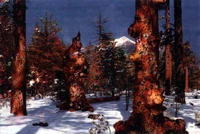
A heavily mutated forest.
A more disturbing method of Tiberium growth is witnessed when the area Tiberium is in has any sort of foliage, such as trees or bushes. Through an unexplained mutagenic process, Tiberium alters these trees into "Blossom Trees" in as little as twelve days.[2] These "trees" are fleshy stalks with a large bulb at the top. The bulb regularly contracts and relaxes, releasing microscopic Tiberium crystals and gases into the atmosphere. As long as there is a Blossom Tree in an area, Tiberium will constantly regrow around the tree.
An alternative method is seemingly used by Tiberium Vinifera, the highly combustible blue Tiberium variant. If a large enough patch of Vinifera grows to maturity, the crystals will meld together into a massive blue crystal, roughly 10 meters high. These large Vinifera masses act similarly to Blossom Trees (it is unknown how), but at a much slower pace.
Post-2034 Tiberium
Following the Firestorm Crisis and the decontamination of the atmosphere, due to unknown factors, Tiberium evolution rapidly accelerated. While Blue Zones were largely unaffected, Yellow and Red Zones suffered greatly, as the new Tiberium is capable of literally fusing with and assimilating organic matter even faster than the old Tiberium.
The new Tiberium is a dense "dynamic proton lattice" held together by exotic heavy particles. When Tiberium comes into contact with other matter, the heavy particles randomly collide with the nuclei of the target matter, smashing it to pieces (in the case of smaller nuclei) or incrementally knocking off protons or neutrons (in the case of heavier nuclei). Tiberium captures a fraction of the protons that are ejected during this collision process and incorporates them into its own structure, thus transmuting matter into more Tiberium. Whenever one of the heavy particles — a muon or tauon — collides with an atomic nucleus, fission occurs, which results in the production of alpha, beta, and gamma radiation as well as other forms of electromagnetic radiation (like infra-red). During the transmutation process, nuclei that Tiberium has come into contact with may be changed into nuclei with different (usually fewer) numbers of protons or neutrons.
This Tiberium also spreads via underground veins, which tend to mass beneath the surface of Earth and, when the concentration is high enough, breaching the surface, creating open, gaping fissures which spread Tiberium crystals around them. The Scrin make use of those fissures by implanting Growth Accelerators on them, which, as their name suggests, speed up the growth rate of Tiberium.
Following the explosion at Temple Prime and subsequent saturation of Earth's atmosphere with Tiberium particulate, the compound underwent yet another evolutionary progression, and started spreading across Earth at a rate several times faster than it had before. All known Tiberium countermeasures, including GDI's prized Sonic technology, became ineffective. As a result, by 2062 Tiberium now covered the majority of the planet. Even areas previously designated as Blue Zones had been completely overrun, and the human race was now facing complete extinction altogether from the crystal. As a result of this extremely dire situation, Kane forged a new Tiberium Control Network with GDI. By 2077, despite growing tensions between the two enemies, this uneasy alliance allowed the network to succeed in driving back Tiberium, reclaiming large parts of Earth. With the green toxic crystal converted into an inexpensive energy source, Tiberium was no longer a threat to humanity, though it had left the majority of the world scarred; being barren, hot, and largely lifeless. Evidence suggests that whole ecosystems were completely overrun or destroyed by the substance by this time, completely altering Earth's environment.[3]
Harvesting and processing
- Main article: Harvester, Refinery, TIberium Control Network
Tiberium 'lives' and 'grows' by a particular way of sucking up nutrients from the ground, leaving it bare and unsuitable for agriculture. The end result of this unique leeching process is that Tiberium crystals can be easily harvested for industrial means with the minimum of mining expense. It is as if Tiberium performs the mining process for the Harvester, with significantly greater efficiency than can currently be counted upon. It was the Brotherhood of Nod that pioneered the mining process, and consequentially, Nod became very wealthy, giving them a large advantage both technologically and economically at the beginning of the First Tiberium War.
On the world market the green crystal is very valuable, and it is the rich mineral wealth of these crystals that has allowed the GDI and the Brotherhood of Nod to amass such huge armies. Although Tiberium is relatively common, it is Tiberium's extreme utility that drives the cost - demand for the compound is extreme, thus, the substance is very valuable despite its high availability.
Nod has created a number of military technologies based on Tiberium, possibly with the information from the Tacitus, including the Chem Warrior, the Catalyst missile, the World Altering Missile, the Liquid Tiberium Bomb, the Tiberium trooper, and has even used Tiberium as a means of altering humanity. Additionally, they were the first organisation to invent successful harvesters and pioneered Tiberium refining.
In the First Tiberium War, the Tiberium refining process began with the dumping of the harvested raw Tiberium into a Tiberium Refinery. The harvest would be transferred to a special centrifuge, where the minerals would be extracted alongside other useful materials, creating a thick, clay-like sludge that was transferred afterwards to the melting furnaces, where it would be molded into elegant bricks, preparing a clean, safe product for further use in Construction Yards, War Factories and other manufacturing centers. Waste and other byproducts would then be stored in barrels and stacked for removal from the refinery or, in Nod's case, some of it would see use in the chemical sprayers for the Chem warriors. Later Nod inventions would make similar uses of these byproducts.
The situation changed after the Second Tiberium War, when Tiberium was further transformed in the wake of Tacitus decontamination procedures. Now, the refineries melted the crystals as their first step in processing it into a safe, usable resource. This harvesting process continued into the Third Tiberium War (2047–2049) with few major changes, save for advancements in robotic extraction and new models of harvester, a notable example being the enormous MARV superheavy tank. During their invasion the alien Scrin race demonstrated several extraordinary methods of Tiberium harvesting, processing, and manipulation, but the sheer advanced nature of these technologies made them difficult for either GDI or Nod to reverse engineer, or even fully comprehend, after the wars end. During the peace years following TWIII Tiberium harvesting and processing remained relatively unchanged until the green crystal underwent another mutation.
By 2062, the evolved crystal could not be harvested altogether and GDI's abatement technologies failed to stop the Tiberium comeback as it became much more aggressive, allowing it to claim alarming amounts of land with no adequate defense against its spread. Further Tacitus decoding revealed that the new Tiberium could be controlled by a new network that will dissipate the crystal surrounding the nodes. The Tiberium Control Network (TCN) was basically one global network of harvesting operations that dissipated the crystals and then converted them into an inexpensive energy source. In this way, the TCN not only performed the duties of harvesting and refining all on its own, but it also contained Tiberium matter and prevented it from spreading outside of very centralized hubs. This advancement rendered previous methods of harvesting and processing obsolete and abandoned, and, in a way, marked humanity's mastery over Tiberium, allowing full control of the substance with minimal consequence.
After the creation of the TCN, Tiberium was no longer a threat to humanity and could no longer proliferate. Raw Tiberium crystals were only seen outside the TCN while being contained in special sonic rings that levitated the crystal samples and prevented them from contacting outside matter and, in the process, multiply.
Composition and types
Harvestable
Riparius
Chemical Composition:
|
This is the most basic form of Tiberium. Its crystals are small and green in appearance, thus it is commonly referred to as "green Tiberium." This type of Tiberium has a low level of leeched minerals and is therefore the least valuable resource, albeit the most available. Riparius grows and spreads very fast.
This was the first type of Tiberium which arrived in the meteorites at the Tiber river and was therefore given the name Riparius (meaning growing near a river). It was the first type of Tiberium extensively studied by Dr. Ignatio Mobius and to this day, remains the most common type.
The most common proliferator of the Riparius was the "blossom tree," which launched Tiberium spores (microscopic crystals) that eventually mature into Tiberium pods. The second means of proliferation is the underground spread via root-like structures. However, Tiberium continues to transform itself. By 2034, Tiberium has become a self-replicating proton lattice that turns any matter it touches into more of itself, giving off powerful radiation in the process. More advanced research has been conducted that indicates that this new Tiberium affects matter on the molecular and possibly even smaller scales. It is advised that all carbon-based lifeforms stay well away from Tiberium.
Vinifera

A small Vinifera crystal patch growing in a Red Zone circa 2058. Note the absence of pods, indicating that Vinifera has evolved over time, just like Riparius.
As Vinifera did not spread noticeably until after the First Tiberium War, Doctor Ignatio Mobius did not manage to study it in great detail before he died. Extensive studying of this tricky crystal by scientists of the Global Defense Initiative has shown that after some time, developed Riparius crystals mature into Tiberium Vinifera, which is blue in appearance, and has crystals about the same size as Riparius. Vinifera is commonly referred to as "blue Tiberium" because of its color.
Vinifera has some special properties which distinguish it greatly from Riparius.
- It spreads much more slowly than Riparius.
- It has a much higher mineral density in a given volume, compared to the Riparius, and therefore has greater economic value.
- It is highly combustible and unstable. It detonates violently when brought into contact with fire, explosives or the Disruptor's sonic weapon.
- It is significantly more harmful to organics, and soldiers often die quicker when traversing a field of blue Vinifera than in a green Riparius field.
When it explodes, it does not blow up all at once. The crystals in a patch blow up randomly, often with gaps of up to 20 seconds between each explosion. The reason for this is as of yet unknown. Vinifera Monoliths began to appear as Vinifera fields spread further. This massive blue crystal form of Tiberium functions like a "blossom tree" but rather than spreading Tiberium Riparius, it spreads Tiberium Vinifera.
A Vinifera crystal kept in a Nod laboratory in the First Tiberium War
Aboreus
Tiberium Aboreus is very similar in appearance to Riparius, and shares many of the same properties. Its value is roughly double that of Riparius and slightly more explosive, but this has not been conclusively proven yet. Apparently there were enough chemical differences for Dr. Mobius to put it in a class of its own. Not much is known about this form of Tiberium. It is thought to be more valuable due to peaking chemical concentrations.
Cruentus
These are large crystals, similar in appearance to the above two strains of Tiberium, except they grow in clumps of approximately 1 square meter to a height of one to two meters. They spread patches of Tiberium Vinifera and Aboreus around them. These crystals are extremely explosive and quite rare. When detonated they shower crystals around the landscape up to 600 metres. This is thought to be a method of spreading Tiberium. It is called "Cruentus" meaning blood-red, even though the crystal itself is dark blue.
Unharvestable
Tiberium Algae
Though this form of Tiberium is called Algae as if it was a form of mutated flora, it is actually Tiberium growing in water. It forms from Tiberium colonies that extended from either Riparius or Vinifera on the sea floor to the surface by strands. It poisons and clogs waterways. By the time of the Second Tiberium War, most of the oceans have been covered by this unhelpful variant of Tiberium which makes travel by ship impossible. This issue has been rectified, as GDI managed to partially decontaminate waters worldwide.
Tiberium creep
A sludge/moss form of Tiberium which marginally slows down travel but is otherwise unobtrusive. Tiberium moss is a sky blue in colour, while the "sludge" is iridescent green. It usually serves as a base for Tiberium flora growth.
Tiberium glaciers
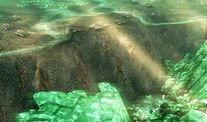
Tiberium Glaciers
Following the abandonment of those parts of the planet designated as Red Zones, the growth of Tiberium there has increased unchecked. The results are found in a large number of vast, towering Tiberium deposits that have engulfed the soil beneath them and created 'glaciers'. These fissures in the Earth's surface create huge barriers for anyone foolish enough to try and cross these regions on foot. Tiberium glaciers, like Ion Storms, are beginning to intrude into Yellow Zones that border Red Zones - notably, Temple Prime was located adjacent to a large Tiberium glacier during the Third Tiberium War. These glaciers resemble crystallised water, implying that they may once be lakes, rivers or seas.
Liquid

A sample of Liquid Tiberium.
Liquid Tiberium was a relatively new form of the alien substance. It is an extremely potent and unstable form that has an extremely high energy density yield. GDI was originally researching its properties in a top secret lab in Australia, under Doctor James De Groot; however, a Black Hand strike force destroyed the lab. This caused massive fallout and accelerated the spread of Tiberium across the continent and turning much of the Australian Outback into a Red zone. When the program was exposed, public backlash was so widespread that GDI promptly shut down the program. Nod, on the other hand, continued to research Liquid Tiberium's properties, and by the Third Tiberium War it was used as both a weapon and a tool by the Brotherhood. (See main article: Liquid Tiberium Bomb)
Liquid Tiberium can be used to seed new Tiberium on unoccupied ground. The new form can be sprayed on a surface, and the microscopic Tiberium particles will embed themselves in the soil and rapidly develop into Tiberium Riparius. It is used as one of the methods of amplifying Tiberium spread. Another use is as a component of the Tiberium Infusion or as a power core of Nod power plants.
Liquid Tiberium would be central to Kane's plan to draw the Scrin to Earth. This was done using a liquid Tiberium bomb underneath Temple Prime and by provoking an Ion Cannon strike on Temple Prime, which triggered a catastrophic detonation of the Liquid T-Bomb that ultimately drew the harvester detachment of the Scrin to Earth. Using the Ion Cannon (the only source strong enough to detonate the inherently unstable liquid Tiberium), the blast yield was two gigatons and caused all proximate Tiberium - regardless of form - to explode.
In response to the invading Scrin, Acting GDI Director Redmond Boyle authorized the construction and use of a liquid Tiberium bomb using Nod's research and components. General Jack Granger was against the plan, as the Scrin were concentrated at Ground Zero (the world's largest Red Zone), and the blast would, in all likelihood, far surpass even the devastating Sarajevo explosion. Ultimately, however, the decision to use GDI's secret Tiberium weapon was left in the hands of the field commander during the battle to destroy the Scrin Relay Node. If used, the detonation would obliterate all GDI, Nod and Scrin forces in the battle and cause an additional 25 million civilian deaths. Though dwarfed by the blast created when the Ion Cannon was fired at Temple Prime, the blast of a liquid Tiberium bomb far surpasses a nuclear bomb's destructive power.
Gases
Chemical Composition:
|
This is a dangerous form of Tiberium which forms toxic clouds. It is often observed being emitted by Veinhole Monsters and Tiberium Floaters. Tiberium gas is highly corrosive in nature and will damage vehicles and buildings. Soldiers without a special suit will die as soon as the gas enters their lungs or when the gas is absorbed into the blood stream. It may cause mutations, turning them into Visceroids. Tiberium gas clouds also damage Cyborgs and Mutants. Fortunately, the concentrations of Tiberium during the First Tiberium War were relatively low compared to what followed.
Ionic
The natural form of ionic Tiberium is found in the ion storms that ravage the Red Zones. Weaponized forms include the GDI Ion Cannon and Nod particle beams. The Scrin use ionic Tiberium weapons in their Devourer Tanks and Reaper Tripods, both of which devour Tiberium, convert it to an energy state and fire a green beam. Their large Planetary Assault Carriers and featherlike Storm Columns can generate ion storms.
Effects on organic matter
- See also Tiberium poisoning
Outcroppings of Tiberium release odorless gases as they appear. While Tiberium was originally considered harmless (and perhaps even beautiful to some due to its unearthly shimmering sparkles), these fumes will heavily poison any carbon-based life form that ventures through it. Radiation can become a dangerous factor as well in higher concentrations of Tiberium.
Long-term, low-level exposure to Tiberium causes illness of various systems amongst all terrestrial life. As the exact mutagenic means by which Tiberium affects terrestrial biology are largely unknown, treatment is generally restricted to alleviating the symptoms rather than curing the cause. Unfortunately, this means that victims of Tiberium poisoning almost uniformly experience a gradual decline over a number of years until eventually succumbing to the effects. A research study that was funded and conducted by GDI during the First Tiberium War produced the following statistics:
| Afflicted System | Humans | Livestock |
|---|---|---|
| Respiratory | 2,447,392 | 9,442,661 |
| Digestive | 3,762,099 | 8,909,700 |
| Immune | 14,681,994 | 29,377,224 |
| Reproductive | 1,446,294 | 12,443,761 |
| Circulatory | 7,885,989 | 16,044,650 |
| Death | 4,286,334 |
11,223,994 |
What was not initially apparent, however, were the intra-organism mutations that could cause subtle mutations seen only within a few generations of exposure. The growth of Tiberium crystals on the skin and flesh, increased resistance to the effects of Tiberium poisoning, and even the ability of tissues to achieve accelerated cellular regeneration when in the presence of Tiberium were only known to Nod researchers.
However, generally, exposure to Tiberium (either a single heavy exposure or a long-term light exposure) will cause death by some form of total system failure.
Tiberium poisoning in humans
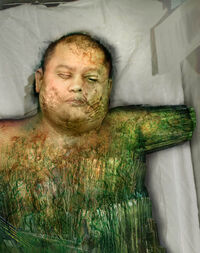
A victim of Tiberium assimilation.
When exposed to very high concentrations of Tiberium, such as while passing through an area of dense Tiberium growth without protective apparatus, the short-term effects of Tiberium poisoning are immediately experienced by individuals. If an individual dies from such exposure, irregular Tiberium mutation can sometimes result. This mutation causes the individual's body to literally break down into a somewhat inside-out, amoeboid organism. These are known as "Visceroids", with the strange tendency to "bleed" fluids in both gaseous and liquid forms. Visceroids tend to feed upon nearby sources of Tiberium, or, if available, they will attempt to digest organic matter of vaguely similar genetic composition to the host organism that preceded them.
Human Tiberium poisoning has become much more dangerous with its evolution: if a human comes into direct contact with Tiberium, the green matter will start to fuse with their skin within about 20 seconds. An intense burning sensation will be felt and a full infection will manifest if the victim isn't treated immediately. The flesh will begin to take on a glassy-greenish appearance as it begins to crystallize; eventually internal organs will shut down as Tiberium extends rigid crystalline runners throughout the body. If the crystal is breathed in, then it will become embedded in the lungs. The ability to process oxygen will be lost as the lung tissue crystallises. Eventually the subject will hemorrhage to death. If the part of the body that is infected is amputated, the infected can be spared further infection.[4]
It should be noted that the new Tiberium does not always kill its victims. As due to unknown factors, a human can survive contact with it and mutate, eventually becoming a human with superior strength and endurance, and the startling ability to repair bodily damage with Tiberium exposure. There is a chance of mental instability. Shunned by most other humans, they usually leave society facing the threat of murder and general distrust. Usually, the mutants die or join a mutant tribe, such as the larger organization of several mutant tribes, the Forgotten in their exodus.
Fauna
- See Tiberian wildlife for a more detailed article.
- Visceroid - As stated above, the amoeba-like Visceroid is a pulsating glob of undeterminable flesh. It is often formed by the Tiberium-related death of a human-sized organism. Some variants of this organism spew Tiberium gases at its enemies, whereas others attack with pseudopods.
- Tiberian Fiend - The 'fiend' is a horse-sized animal, resembling a terran dog. The flesh is blackish or red, and the back is covered with Tiberium crystals. It is believed Tiberium fiends were actually once dogs, although they are more reptillian on closer examination. The fiends can launch these crystals at enemies, causing both damage as well as Tiberium poisoning. Often, they bury themselves in Tiberium fields and lay in wait to attack anything they perceive as a threat. However, they will and do react to perceived acts of kindness, and the Forgotten have been able to tame a significant number of them for use as watchdogs.
- Tiberian Floater - Looks like a large, hovering/floating, greenish/yellowish jellyfish. It can build up an electrical charge in its tentacles to zap threats. The Tiberium floater can release Tiberium gas to propel itself, as a way of movement.
Flora
Though limited in variety, Tiberium-based flora exists:
- Blossom Tree - Sometimes referred to as Tiberium spore trees. Blossom Trees were born when normal trees come into prolonged contact with Tiberium. Once contact was made, the tree will slowly begin to mutate and develop a fleshly stalk, with a pulsating bulb periodically releasing Tiberium spores to the surrounding area. When these spores land on the ground, a new Tiberium field will begin forming. Blossom trees could spread green Tiberium at an alarming rate, and were known to sprout from any type of tree species. However, after Tiberium's evolution, they disappeared almost completely, leaving withered husks of dead trees behind.
- Veinhole Monster - Perhaps the oddest Tiberium lifeform, the Veinhole Monster is a massive mouth-like orifice in the ground, with many orange tendrils flowing outwardly from the mouth. These tendrils harm anything heavy enough to damage them and release concentrated Tiberium vapor when the central node is threatened, the effects of which are accelerated Tiberium poisoning to both infantry and equipment. They were harvested by Nod for use in chemical weapons.
- Tiberium Plants - These plants have not been given names. The scientific background is that they release Tiberium gas and add to the suspected terraforming process of Tiberium. These plants come in both blue and green variants and grow either on the Tiberium creep or on terrain soil. Some of these plants seem to have developed rudimentary intelligence, enough to respond to their surroundings and threats.
A dead Tiberian Blossom Tree during the Third Tiberium War
Behind the scenes
There are other materials (real or fictitious) said to have similar properties to Tiberium these include:
- Strange matter is a hypothetical material which is theorised to convert any ordinary mass it comes into contact with into more strange matter. If there were any loose on Earth it would ultimately convert the entire mass of the planet into strange matter forming it into a quark star. As of yet it remains theoretical.
- Metallic Hydrogen is a material formed by compressing hydrogen to huge pressures (a million atm at least) until it gains metallic properties and behaves like an alkali metal. It is made up of a crystalline lattice of protons, similar to the "dynamic proton lattice" that Tiberium is said to be composed of. Also, it is theorised to have liquid form under certain circumstances (like Tiberium) and can, possibly, be used as a fuel source. It is believed to exist in the center of gas giants and was reported to have been briefly produced in 1996.
- Ice-nine is a fictitious form of ice from the novel Cat's Cradle which has a melting point well above room temperature. This means it can convert most of the naturally occurring water it touches into more ice-nine (much like regular ice in supercooled water). In the novel, its spread throughout the oceans causes an environmental catastrophe.
- Phazon is a fictitious substance of extragalactic origin in the Metroid video game series. It is similar to Tiberium in that it is of extraterrestrial origin, is extremely prized due to its energy output, and can also kill any beings which come in contact with it, although it some beings can live with it if not killed initially and actually become stronger and faster as a result, similar to Tiberium Mutants. Animals can also be mutated by Phazon, like the Tiberium fauna and flora in the C&C universe. Inanimate matter and creatures killed by Phazon turn (and in some cases living organisms too) into more Phazon, just like inanimate objects and creatures exposed to Tiberium. Like Tiberium, Phazon is also partially sentient, and comes in many different varieties. Like Tiberium, it can also be used in weapon systems. Also, it is launched from space to reclaim other planets and make them suitable for phazon wildlife. Last but not least, both the Galactic Federation and Space Pirates have utilized the substance as a combat weapon like Nod, with devastating results. This doesn't come without the risks to the user, though, as the substance is known to mutate and assimilate unfortunate wielders on occasions.
- The Apocalypse Virus in anime Guilty Crown has similar symptoms to Tiberium poisoning, most notably crystallization of the body, eventually leading to death. Like Tiberium, the Apocalypse Virus arrived on Earth by a meteor.
Trivia
- Tiberium was inspired by the 1957 B-movie The Monolith Monsters and Dune's primary resource, "Spice"
- The Sims 3: World Adventures contains Tiberium that can be obtained in the form of a relic from Egypt, combining certain combinations of relics using a Carter's series display case, or breaking space rocks using the Board Breaker. It will start out as a small Spire Cut Tiberium that can be sold for 89 Simoleons, but within a single day, it will become a Large Spire Cut Tiberium worth 30k Simoleons. Leaving a piece of Tiberium in a Sim's inventory for a while will give the Sim "Visceroidal Nausea", which drops the Sim's mood by 20, causes them to become very sick and vomit frequently.
- In SimCity 4, when placing industrial zones, a high-tech industry named Kane Tiberium will appear.

Telephone screenshot showing Tiberium on the list
- In the Telephone video by Lady GaGa, one cup of Tiberium is seen on the list of poison ingredients.
- Tiberium arrived on the Tiberium universe Earth on the same year Command & Conquer was released in the real world.
- Kane claims that he named Tiberium after Tiberius Drusus Caesar, who was the Roman emperor at the time of Jesus' Crucifixion, yet another one of the biblical references in the Tiberium universe.
- In Tiberian Sun, if Tiberium manages to spawn on the same location as a tree, hovering the cursor over it would label the tree as a Tiberium Riparius. However; since the tree is still in its very early stages of exposure, it does not distribute any additional Tiberium.
- Tiberium can be considered as an extreme case of bioconcentration or bioaccumulation. It can also be considered as an extreme case of (extraterrestrial) invasive species.
See also
- Tiberium related images
- Project ReGenesis
- Cybernetics
- Scrin
- Kane
- Living With Tiberium
- Tiberium shards
- Forgotten
- Military applications of Tiberium
- A Little About Tiberium
References
- ↑ Renegade in-game sound effects
- ↑ Background on the conflict, part 2 - Tiberian Dawn GDI campaign
- ↑ Command & Conquer 4 Q&A - Exclusive First Details, page 2 Command & Conquer 4 Q&A - Exclusive First Details, page 2. GameSpot. July 9, 2009.
- ↑ Command and Conquer: Rivals – Official Gameplay Overview. EA YouTube channel. June 9, 2018














